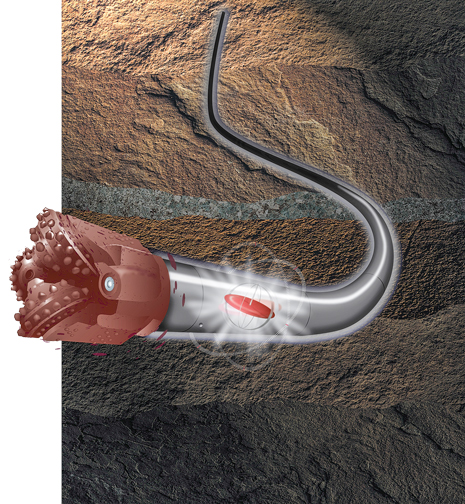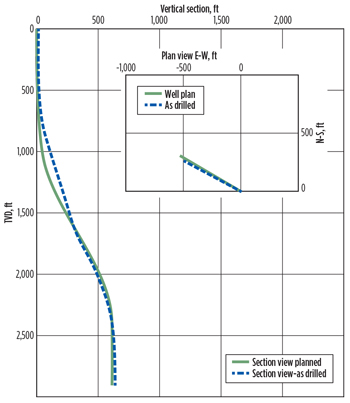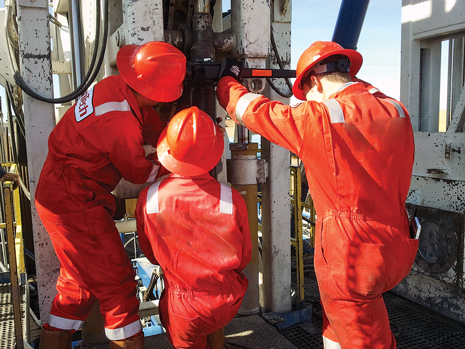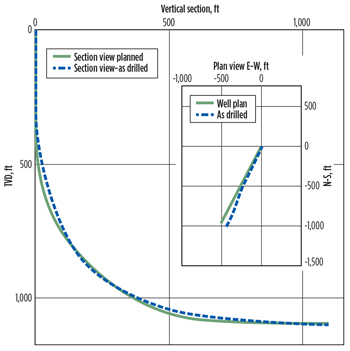Directional CTD advances enable drilling of low-margin wells with minimal environmental impact
|
Operators are always looking for an economical and environmentally sensitive way to access mature oil fields. It is a continuing source of frustration for the industry, because the two proven techniques for increasing reserve recovery—horizontal drilling and underbalanced drilling—are not economically combined with standard, jointed pipe drilling. Plus, the speed advantages of coiled tubing drilling (CTD) cannot be fully exploited, because it doesn’t lend itself to drilling directionally with larger hole sizes. AnTech Ltd, a directional coiled tubing drilling (DCTD) specialist, recognized that an economical solution lay in the DCTD speed and underbalanced capabilites. In 2009, the company began developing a DCTD tool, that would drill larger-diameter horizontal wells. The POLARIS tool is a 5-in.-OD bottomhole assembly (BHA), targeted at drilling directional, S-curve and horizontal wells. It is capable of drilling in these profiles, because it is steered using AnTech’s patented solid state Acrobat gyro-directional sensor, that provides horizontal gyro-while-drilling (GWD) capability. With the gyro sensor located just behind the motor, quick directional feedback is produced, providing a more precise, controlled trajectory, Fig. 1.
The POLARIS tool was developed to provide a CT method to drill the larger hole sizes. The introduction of the solid-state gyro allowed the sensor to be located closer to the bit, nearly halving the BHA length, which is less than 40 ft overall, between bit and coil connector. It also meant that the tool could be built from less-expensive standard materials, without the need for non-magnetic collars and without sacrificing its GWD capability. NIOBRARA DRILLING CAMPAIGNA five-well drilling campaign carried out by AnTech, with the POLARIS tool in the Kansas Niobrara formation, demonstrated that the system reliably drills directional, S-curve and horizontal wells. AnTech designed the Niobrara campaign to put the POLARIS tool to the test, making certain that the challenging operation would demonstrate the tool’s ability to re-enter mature wells and economically access this shallow reservoir. To keep costs to a minimum, the surface section of every well was drilled, and casing set, using a water-well rig. Given the extremely low margins associated with the wells, no pad or access road was prepared in advance, further highlighting the environmental advantages of this particular program. During Phase 1, AnTech drilled three wells overbalanced with mud. The first well was an S-curve, while the remaining two wells were deviated to varying degrees. Throughout the drilling campaign AnTech used a hybrid drilling rig in cooperation with a CTD rig specialist. The benefit of using this type of drilling rig is that drilling time can be reduced by as much as 60%, as compared with drilling with a conventional jointed pipe rig. Well 1 was an S-curve drilled to nearly 3,000 ft, TVD, and over 600-ft lateral displacement, Fig. 2.
The reservoir targeted for drilling was situated beneath productive farmland. AnTech located the rig on neighboring land, making certain to set the trajectory, so that the landowner would not be disturbed, Fig. 3.
The reservoir targets of Wells 2 and 3 were situated below creeks, making it impossible to place the rig directly above the target. As a consequence, deviated wellbores were drilled. In less than one day, the POLARIS tool accurately drilled Well 2 to more than 1,500 ft, TVD, with an average dogleg severity of approximately 7.5°. The third well was drilled near Goodland, Kan., with an 1,100-ft TVD and 700-ft lateral displacement. This Phase I third and final well was completed, as planned. All three wells drilled validated that the solid-state Acrobat gyro system reliably monitors the orientation of the tool, making it easy to accurately drill along a specific path. NO COUNTRYSIDE DISRUPTIONBy using the POLARIS tool to drill directionally, AnTech accessed targets without disrupting the surrounding environment. This could not have been achieved, had the wells been drilled vertically. Located under a hill and riverbed, and bordering a cornfield, they were situated in areas without drill pads or access roads in place. The only way that such low-margin operations make economic sense is to make certain that they are mobilized and drilled rapidly. Phase 1 confirms that this is achievable. Due to the highly fractured formation that was incapable of supporting the pressure of a liquid column, air was used to drill Wells 4 and 5 in Phase 2. Using an 8½-in. bit, the build sections of these wells were drilled with mud, while the horizontal sections were drilled with an air mist, using a 6¼-in. bit. A unique benefit of the POLARIS tool is that it produces reports of downhole vibration in real time. In Phase 2, the accelerometers recorded shock spikes of up to 350 g during air drilling—more specifically, with the bit off-bottom. Measuring vibrations is extremely important, so it is critical that the equipment can withstand the punishing vibration and shock experienced when drilling with aerated fluids or in air. Well 4 was drilled horizontally to a 1,090-ft TVD and over a 1,450-ft lateral displacement. AnTech then executed the final operation on horizontal Well 5, drilling it to 1,096-ft TVD, with a lateral displacement of 1,103 ft, Fig. 4.
The final two wells highlighted the effectiveness of the POLARIS tool, which successfully drilled horizontal and directional wells. Table 1 shows the key statistics of all the five wells drilled during the Niobrara campaign.
FIELD PERFORMANCEPhase 1 benefited from the POLARIS tool’s ability to target a precise location within the reservoir without having to position the rig directly above the target. During Phase 2, directional CTD was used to air-drill a reservoir that was incapable of supporting a liquid column. Overall, the program demonstrated that by using the POLARIS tool, it is possible to drill horizontal and directional wells with 6¼-in. to 8½-in. holes, while using mud or air mist as drilling fluid. For AnTech, it was particularly significant, because it was the first time that a solid-state gyro had been used for directional measurement-while-drilling. The Acrobat gyro system generated valuable data at all inclinations, including horizontal, which meant that orientation was accurate, even in the casing. The program offers firm evidence that wells can be drilled in shallow reserves, without affecting the environment or requiring heavy investment. Furthermore, it illustrates that well plans can be followed precisely. Well paths can also be enhanced by kicking off early, with the gyro situated in the casing, which reduces build rates, making casing running more efficient. In addition to the POLARIS tool and the experienced CTD team, AnTech attributes its success to the hybrid drilling rig. Without the hybrid drilling rig, which runs CT and jointed pipe as well as running and pulling casing, these operations would not have been possible. Because they are so adaptable, CTD is easily achieved with a single rig. DCTD SUITABILITYFor years, CTD has been the method of choice for drilling underbalanced, within a reservoir. Now that CTD can directionally drill much larger holes, fields previously thought to be inaccessible, because they didn’t make economic sense to access, can be exploited. Operators should consider CTD for re-entry and development programs, where the reservoir and geology conditions are uncomplicated. For those planning to carry out a stand-alone or wildcat project, CTD is not the answer, because the benefits of efficiency and speed do not have the chance to be fully realized. In addition to the applications illustrated by the Niobrara program, DCTD is highly beneficial when drilling in these circumstances:
During the past 20 years, CTD has been embraced as a means of accessing untapped reservoirs, particularly in Alaska, Russia and Saudi Arabia for directional wells, and Canada and the U.S. Lower 48 for vertical wells. Currently, there are CTD operations being undertaken in Malaysia and Australia. Given the cost-savings, speed, and environmental benefits it provides, DCTD is gathering wider market acceptance. With the arrival of new technologies, such as the POLARIS tool that drills simple shallow wells to multiple wells from a single pad, DCTD’s time has come. |
||||||||||||||||||||||||||

- Coiled tubing drilling’s role in the energy transition (March 2024)
- Using data to create new completion efficiencies (February 2024)
- Digital tool kit enhances real-time decision-making to improve drilling efficiency and performance (February 2024)
- E&P outside the U.S. maintains a disciplined pace (February 2024)
- Prices and governmental policies combine to stymie Canadian upstream growth (February 2024)
- U.S. operators reduce activity as crude prices plunge (February 2024)







